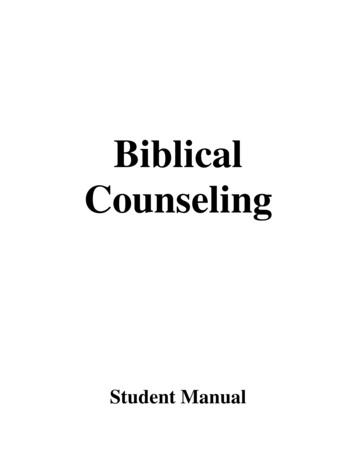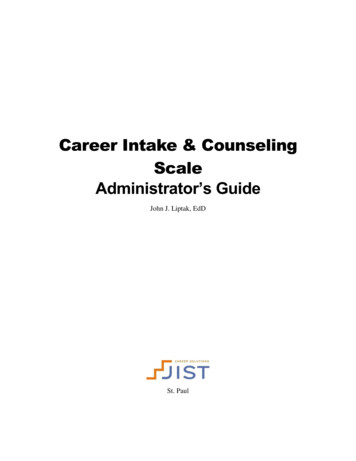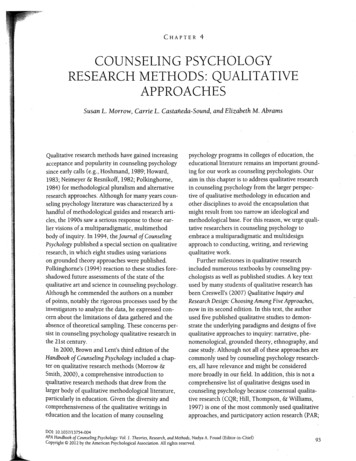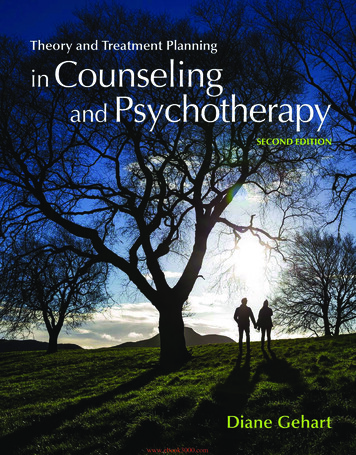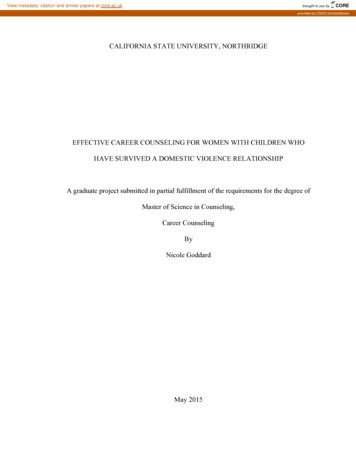
Transcription
View metadata, citation and similar papers at core.ac.ukbrought to you byCOREprovided by CSUN ScholarWorksCALIFORNIA STATE UNIVERSITY, NORTHRIDGEEFFECTIVE CAREER COUNSELING FOR WOMEN WITH CHILDREN WHOHAVE SURVIVED A DOMESTIC VIOLENCE RELATIONSHIPA graduate project submitted in partial fulfillment of the requirements for the degree ofMaster of Science in Counseling,Career CounselingByNicole GoddardMay 2015
SIGNATURE PAGEThis graduate project of Nicole Goddard is approved:Gretchen Maldonado, M.S.DateShaina Phillips, M.S.DateShari Tarver-Behring, Ph.D.DateMerril A. Simon, Ph.D., ChairDateCalifornia State University, Northridgeii
DEDICATIONThis graduate project is dedicated to Marie Dahan and Dr. Gregory Jackson.These two individuals made Career Counseling an option for me and ignited my passionfor the field.Marie Dahan, my mentor and advisor when I first began community college. Ithank you for all of your genuineness as a Counselor and your words of wisdomthroughout all of my college years. It has been a pleasure to work alongside you andlearn from your journey. I can say with all honesty, that you were one of my biggestreasons for moving on to graduate school because of your encouragement and ability tohelp me recognize my true potential.Dr. Jackson, I had never met another human being so passionate about the field ofCareer Counseling. The simplest questions you ask bring out an array of new emotions,thoughts, and ideas because you have the gift of knowing how to get a person to open up.I thank you for opening my eyes to this specialization and showing me what this field hasto offer.iii
ACKNOWLEDGEMENTSI would like to acknowledge both of my parents and my extended family forproviding me with emotional support and encouraging me to never give up during thebusiest and most stressful times. I thank you for allowing me to fulfill my dreams andfollow the path that makes me happy. There is no way I would have had this muchgrowth and development in my life if it were not for you all, specifically you mom anddad. I love you and I will continue to make you proud and give back for all you havegiven me. To you, Andrea, I hope I am someone you can look up to in your future. Iappreciate our weird way of showing love to each other.Julie Hau, I can’t thank you enough for the support you gave me in the short timeyou were our Director. You spent countless hours making sure our graduate schoolexperience was full of engaging activities. I felt the most comfortable to see you in youroffice for your wonderful insight when times were difficult.To my small cohort, Arpi and Jess, I owe the world to you girls. In the last threeyears, you two have been my rock with deadline reminders, weekend shenanigans, grouptexts, and witnessing each other’s high and lows. Graduate school could not have beenthe same without you. Also, Tyrone, an addition to our cohort, but fit in just perfectly.Thanks for reminding me to live in the present.To my Family Resource Center family, Jeanette, Gary, Marni, Tania, and Amber:Thank you for being my shoulder to cry on! No one could understand this journey better.Thank you to Merril, Shaina, and Gretchen for working through your busyschedules to help me develop myself as a professional. I appreciate your assistance in myproject. Also, thank you to my four evaluators for assessing my program.iv
TABLE OF CONTENTSSIGNATURE PTER I: Introduction1Statement of the Problem1Importance of the Problem2Identifying the Focus Group2Characteristics of the Focus Group3Introduction to Theoretical Approaches4Social Cognitive Career Theory4Super’s Developmental Self-Concept Theory5Schlossberg’s Transition Theory5Consequences of the Problem6Limitations7Technical Terminology for Project7CHAPTER II: Review of the literature9Summary of General Theoretical PerspectivesSocial Cognitive Career Theory99Super’s Developmental Self-Concept10Schlossberg’s Transition Theory10v
Literature Review11Barriers12Mental Health Issues12Low Self-Efficacy13Issues in the Workplace13Economic Abuse15Disclosure of Domestic Violence16Resiliency17Career Issues and Interventions18Existing Programs for the Focus Group20Theoretical Approaches Relating to Women from Abusive Relationships21Social Cognitive Career Theory21Super’s Career Development Theory24Schlossberg’s Transition Theory25Summary and Transition to Chapter 327CHAPTER III: Justification of the Career Development Project29Structure of Program29Location and Staffing31Assessment31Summary and Transition32CHAPTER IV: Proposed Career Development ProgramOverall Program Goals and Objectives3333vi
Session 1: Intake Session34Session 2: Creating Goals36Session 3: Brainstorming Life Roles38Session 4: Transferable Skills40Session 5: Identifying Interests41Session 6: Résumé Writing43Session 7: Informational Interviews45Session 8: Mock Interviews46Closing Session – Evaluation47CHAPTER V: Project Evaluation48Evaluator Qualifications48Evaluation Questions and Responses49Limitations of the Program57REFERENCES59Appendix A: Intake Form63Appendix B: Confidentiality65Appendix C: Creating Goals66Appendix D: Safety Plan Form69Appendix E: Life Roles70Appendix F: Transferable Skills Form71Appendix G: Résumé Guide72Appendix H: Résumé Example73Appendix I: Informational Interviewing75vii
Appendix J: Online Career Resources77Appendix K: Interview Preparation78Appendix L: Program Evaluation Form80Appendix M: Questions for Evaluators81viii
ABSTRACTEFFECTIVE CAREER COUNSELING FOR WOMEN WITH CHILDREN WHOHAVE SURVIVED A DOMESTIC VIOLENCE RELATIONSHIPByNicole GoddardMaster of Science in Counseling,Career CounselingWomen in domestic violence relationships have a multitude of barriers that affectboth their degree of independence and career development. While in an abusiverelationship they face mental health issues that affect their self-efficacy and their sense ofsafety. Additionally, the women become more dependent on their spouse financiallybecause the control of the their ability to work and financial issues that arise fromspousal harassment in the workplace or inability to work at all. Furthermore, they needthe proper knowledge and support to identify their skills for the world of work to becomefinancially independent. When the women leave their abusive relationship they faceadditional barriers that include lack of childcare, transportation, and housing, which willalso be addressed. This project will outline the characteristics, problems, and needs ofthe population to create a career development program. The program itself applies theSocial Cognitive Career Theory, Super’s Developmental Self-Concept Theory, andSchlossberg’s Transition Theory.ix
CHAPTER I: INTRODUCTIONThere are a large number of cases of domestic violence (DV) in the United States,with a higher rate being against women. The abusive relationship is a continuoustraumatic cycle that is difficult to escape and affects an individual’s self-efficacy. Once awoman has escaped her abusive situation, it is difficult to be economically independentand build a stable environment for oneself, if relevant, and her children. Careerexploration and development is usually not a primary focus for these individuals, so workopportunities tend to be only short term. However, with professional guidance, the careerdevelopment process can be achieved to create a stepping-stone to a successful life.Statement of the ProblemBrowne, Salomon, and Bassuk (1999) found that women who are in or have left aviolent relationship that lasted at least twelve months are 33% as likely as women innonviolent relationships to maintain stable employment in the next six months. Womenin domestic violent relationships do find employment. However, when the factors suchas hours worked and work experiences are evaluated, differentiated problems arediscovered. Some factors involved are poor attendance at work, excessive personalphone calls, poor job performance, and the abuser showing up too many times while thewoman is “on the clock” (Adams, Tolman, Bybee, Sullivan, & Kennedy, 2013). Oncethe woman has left the relationship, she may face additional issues that include lack oftransportation, child-care, and housing as well.In addition to these issues, this population of women who have experienced DVoften has limited knowledge of the world of work or assistance on how to find long-termcareer satisfaction and success to improve their lives due to the psychological impacts of1
their past trauma. The constant change of occupations or being a stay-at-home mothercan make it particularly difficult to be successful in the workplace unless the individual isaware of the transferable skills that they have developed. Career exploration anddevelopment is part of the process for women who have experienced DV to build a stablelife.Chapter 1 of this project will discuss the general characteristics and needs for thispopulation. Additionally, an introduction of the Social Cognitive Career Theory, Super’sDevelopmental Self-Concept Theory, and Schlossberg’s Transitional Theory will beprovided.Importance of the ProblemWork tends to serve primarily as a survival tool for women in domestic violencerelationships. Therefore, they may have limited time or resources to develop, explore,and discover a career that fits their passion (Chronister, Wettersten, & Brown, 2004).Intimate partner victimization interferes with the survivor’s ability to go to work, attendschool and develop their skills that are critical for the career development process.Moreover, the lack of child-care, safety, shelter, and transportation becomes the primaryneeds to be addressed. Without outside support and guidance, this transition fromabusive relationship to independence can seem unachievable.Identifying the Focus GroupThe identified population for this project is women who have been out of theirdomestic violence relationship for at least a year. It is estimated that 95% of victims ina domestic violence relationship are female (Berry, 2000; Centers for Disease Controland Prevention, 2009), explaining the focus on women. Domestic Violence will be2
analyzed in all aspects, including women who endured physical, sexual, verbal,economic and/or emotional abuse (Cowell & Burgess, 1996). Additionally, the focusgroup will specifically target women who have children. This population has anadditional unique set of barriers they may face while trying to regain theirindependence.Characteristics of the Focus GroupFor this project, the focus of the population will not be in one particular race, socioeconomic status, or religion because domestic violence relationships are not biasedtoward one type of individual. However, it has been found that poor women, as well aswomen of color, may be at higher risk because of disadvantaged social positions, andinadequate access to resources (Sokoloff & Dupont, 2005). This factor cannot be ignoredand should be further studied in order to effectively assist the varying needs ofindividuals with different demographic characteristics.Many of these women are isolated from social and personal resources (Browne,1993), which in turn will make it difficult for them to rebuild these relationships andsupport systems once they have broken free from the violent relationship. Furthermore,even when a woman has removed herself from the abusive relationship, she may spendyears suffering from shame and guilt (Browne) regarding her decision to stay within anabusive relationship, especially if she has children who have been negatively affectedfrom the decision.In domestic violence relationships, women tend to lose their sense ofindependence and autonomy. The partner or spouse creates a dependent relationshiptypically by different forms of establishing dominance through power and control; this3
can include economic abuse (Postmus, Plummer, McMahon, Murshid, & Kim, 2012).Forms of economic abuse may include the abuser’s being in charge of all income,preventing the spouse from working, and/or harassing them in the workplace. Estimatessuggest 75% of employed battered women are harassed in their work setting by abusers,and 54% of them lose their job because of it (Cowell & Burgess, 1996).Introduction to Theoretical ApproachesA theoretical framework is important to reference when creating interventions forany population. The theoretical approaches that will be applied in this project willinclude Social Cognitive Career Theory, Super’s Developmental Self-Concept Theory,and Schlossberg’s Transition Theory. In this section, a brief overview will be providedof each.Social Cognitive Career TheoryThe Social Cognitive Career Theory discusses the cognitive variables, includingan individual’s level of self-efficacy, outcome expectations, and personal goals, whichallow them to have personal control in their career development Additionally, thesevariables are also affected by the environment, physical attributes (e.g. sex and race), andprior learning experiences (Lent, Brown, & Hackett, 2000). This is beneficial forworking with women from abused relationships because research has showed that thesevariables are greatly affected in their lives. Specifically, the environment they have livedin has temporarily interfered with their ability to exercise their personal control. Theapplication of this theory involves helping an individual create goals towards their careerdevelopment, developing self-efficacy, and creating a safe, socially welcomingenvironment.4
Super’s Developmental Self-Concept TheorySuper’s Life-Span, Life-Space theory involves the different stages that anindividual goes through. Depending on the life roles they participate in (e.g., parent,spouse, student), they may place a different value on their experiences (e.g., their job)(Super, Savickes, & Super, 1996). This theory focuses on both the adjustment and choiceof roles, especially the work role. When an individual chooses a new work role, thechoice will depend on the abilities and interests that the individual has developed,combined with what the workplace requires. It is determined to be a good fit when theperson who has entered the new occupation feels a sense of job success, satisfaction, andstability (Super, et al.). Through the career development process, one can increase theirself-concept and identity awareness. Interest assessments can be a beneficial startingpoint to become aware of the potential matches between themselves and the workplace.Schlossberg’s Transition TheorySchlossberg’s Transition theory states that transitions alter our lives in terms ofour roles, relationships, routines and assumptions. There are three types of transitionsthat occur: Anticipated, Unanticipated, and Nonevent transitions (Schlossberg, 2011).Anticipated transitions are changes in events that we expect to happen, such as graduatingfrom school. Unanticipated transitions are changes in events that unexpectedly occur andmay cause angst or chaos, such as a car accident. Lastly, the Nonevent transitions arechanges that are expected to occur, but do not, such as getting married as planned(Schlossberg, 2011). Each individual has a different way of processing these transitions.For some, it may be an easy transition, but for many the transition will take time to copewith.5
Transition theory outlines the four S’s that affect the way an individual copes witha transition. The first “S” is Situation, which refers to what the individual’s life situationis like at the time of the transition. If he/she is not having multiple stressors at one time,the transition will likely be easier to adapt to. The second “S” is Self, which refers to howwell an individual reacts to a situation (e.g. optimistic vs. pessimistic). The third “S” isSupports. Having a well-established support system is important during the time of atransition for the individual’s healthy well-being. Supports can include professionalorganizations, resources, counselors, family, and friends. The last “S” is Strategies,which outlines the importance of using multiple strategies to cope with new situations(Schlossberg, 2011). There is no perfect coping strategy for a given transition, so onemust be flexible and adapt to different methods depending on the situation. The four S’sare critical to understand when working with individuals to help them understand thetransition process, how it is affecting them, and how to best cope with the life changes.Consequences of the ProblemAs stated above, domestic violence relationships could be defined as dealing withphysical, economic, emotional, and/or verbal abuse (Cowell & Burgess, 1996), which cancreate an abundance of issues for an individual. The abuse affects both the psychologicaland emotional well being of the individual involved. In terms of Career Development,the economic abuse and control from the spouse creates a dependent relationship inwhich the survivors of domestic violence are without support and resources to develop intheir career or educational path.In a study by Browne, Saloon,and Bassuk (1999) it was found that women inabusive relationships had a low likelihood of having a job that was full-time or that lastedlonger than 6 months compared to women who were not.6
LimitationsThere are several limitations to this project. Due to the lack of extended researchwithin this population, the project has a very broad view of interventions. The researchlacks a focus on the career development of women specifically who have escaped adomestic violence relationship and are now working to build their lives throughout time.Additionally, there is limited information regarding the differences that may occuramongst different race, ethnicity, culture, as well as differences among women’sexperiences related to the amount of time they have been out of the relationship.This program will also not be able to address all of the barriers and needs for thispopulation. The program will focus primarily on the career development of the womenparticipants with the desired outcomes of building their self-efficacy and helping them tobecome goal oriented. The program will not focus on the children’s or parent’s mentalhealth issues or the cycle of abuse. However, psychological groups and counseling willbe required for the participants and safety plans will be established.Technical Terminology for ProjectIn this section, the common technical terms are defined as each pertains to thisproject. The definitions were provided from a variety of professional sources usedthroughout.Social Cognitive Career Theory – A career theory based on the “mechanisms of selfefficacy and outcome expectations, contextual barriers and supports, and personal goals”(Chronister & McWhirter, 2004, p. 170).Domestic Violence (DV) – Victims in a relationship that may be “physical (e.g.,punching), sexual (e.g. physically forcing sex), psychological (e.g. humiliating in private7
or public), and/or economic abuse (e.g., sabotaging attempts to work or to go to school)”(Chronister, Brown, & Wettersten, 2004, p. 900).Battered Women – “Female victims of domestic violence” (Collins, 2011, p. 246).Self-efficacy – “Belief in one’s ability to perform specific behaviors” (Chronister &McWhirter, 2003, p. 419).Outcome Expectations – “Beliefs about the likely consequences of performing specificbehaviors” (Chronister, 2006, p. 176).Critical Consciousness –Critical consciousness is the “awareness of power dynamics atwork in her life” (Chronister & McWhirter, 2001).Survivor – can be defined as an individual who has left their intimate partner violencerelationship, which could be for many reasons, including gaining a sense of self and hopefor the future, gaining an awareness of a safe place to escape to, and having confidencethat there is community support available (McLeod, Hays, & Chang, 2010)Career Counseling - defined as the “process of assisting individuals in the developmentof a life-career with focus on the definition of the worker role and how that role interactswith other life roles” (National Career Development Association, 1997)Intimate partner violence – “physical, sexual, or psychological harm to a person by acurrent or former partner or spouse” (Domestic Violence Awareness Month, 2005)Resiliency can be defined as “personality traits and coping strategies that enable a childor adult to overcome harrowing life experiences” (Kragh & Huber, 2002, p. 294).8
CHAPTER II: Review of the literatureThis chapter will provide a review of the literature relating to the multitude ofbarriers that women from abusive relationships face and how this can interfere with theircareer development process. These barriers include mental health issues, issues in theworkplace, economic abuse, difficulty disclosing the abuse, low self-efficacy, and more.The theoretical perspectives used in this Career Development Program will alsobe described. The theories discussed will be Social Cognitive Career Theory, Super’sDevelopmental Self-Concept Theory, and Schlossberg’s Transition Theory and how eachcan be applied to this population when creating a successful program.Summary of General Theoretical PerspectivesThis career development program created is based on the theoretical perspectivesof Social Cognitive Career Theory, Super’s Developmental Self-Concept, andSchlossberg’s Transition Theory. In this section, a general summary will be provided foreach theory.Social Cognitive Career TheorySocial Cognitive Career theory has been applied to women in domestic violencerelationships in past intervention programs and research. It is based on Albert Bandura’sSocial Cognitive Theory, which is the process of discovering career and educationalinterests, the choices an individual makes, and the work an individual puts in towards theengagement of these endeavors. Later, the theory added environmental influences andthe acknowledgement of the various roles of an individual. Additionally, thoseindividuals take an active part in their experiences and growth (Chronister & McWhirter,2003).9
The three aspects that have been applied to this population are self-efficacyexpectations, outcome expectations, and personal goals. This can be explained, as thelevel in which in individual believes in him or herself to perform tasks (self-efficacyexpectations), the belief that that their abilities will lead to certain payoffs (outcomeexpectations), and the knowledge that one must act on his or her goals to create change(personal goals) (Lent, et. al, 2000).Super’s Developmental Self-ConceptCareer self-concept theory involves an individual’s own perspective on thepurpose of their experiences and how it relates to abilities, interests, values, and choices(Super, Savickas, & Super 1996). This framework takes on the subjective approach; themeaning behind experiences using verbal, nonverbal, and written stories, rather thanfocusing primarily on an assessment that is compared to others. This approach highlightsthe strengths and uniqueness of each individual and how they see themselves in relationto the world of work. Life situations are ever changing, which is why this development isa long-term process.Super defines self-concept as a “picture of the self in some role, situation, orposition, performing some set of functions, or in some web of relations (Super, Savickas,& Super, 1996).” It is critical for self-concept to be developed and understood by theindividual because if it is unrealistic or negative, a person may become indecisive whenmaking a match to an occupation.Schlossberg’s Transition TheorySchlossberg’s Transition theory focuses on transitions and the way they alter ourlives in terms of our roles, relationships, routines and assumptions. There are three types10
of transitions that occur: Anticipated, Unanticipated, and Nonevent transitions(Schlossberg, 2011) and this can make a difference in how the transition affects anindividual. Transition theory outlines the four “S”s that play a role in how an individualcopes with a transition. The first “S” is Situation, which refers to what the individual’slife situation is like at the time of the transition. If he/she is not having multiple stressorsat one time, the transition will likely be easier to adapt to. The second “S” is Self, whichrefers to how well an individual reacts to a situation (e.g. optimistic vs. pessimistic). Thethird “S” is Supports. Having a well-established support system is important during thetime of a transition for the individual’s healthy well-being. Supports can includeprofessional organizations, resources, counselors, family, and friends. The last “S” isStrategies, which outlines the importance of using multiple strategies to cope with newsituations (Schlossberg, 2011). These will be explored in more depth into how theyapply to working with the population of women who have survived a domestic violencerelationship.Literature ReviewAccording to the Centers for Disease Control (2003), “about 5.3 million partnervictimizations occur every year among women who are age 18 years or older, whichresults in nearly 2 million injuries to women and almost 13,000 deaths each year”(Chronister, Harley, Aranda, Barr, & Luginbuhl, 2011, p. 516). The U.S. Department ofJustice (2000, 2001), reported that “64% to 85% of domestic violence victims are womenand domestic assaults may be physical, sexual, psychological, and/or economic abuse”(Chronister, Wettersten, & Brown, 2004, p. 900). Additionally, estimates suggest 75% of11
employed battered women are harassed in their work setting by abusers, and 54% of themlose their job because of it (Cowell & Burgess, 1996)Researchers have studied the barriers that women face when trying to leave anabusive home environment. These barriers include lack of support from family andfriends, fear of not being safe in a new environment, and limited or no financial stability.Women who remain in the home of a domestic violence situation are less likely to seekout and/or be successful in a treatment plan that develops independence and self-efficacyskills (Chronister & McWhirter, 2006). Literature shows that stress, depression, andanxiety disorders also make it difficult for women to leave an abusive relationship. Theymay feel trapped and learn to believe it is the only way to live (Collins, 2011).BarriersMental Health IssuesResearchers have various views on the extent in which women from domesticviolence relationships have experienced PTSD symptoms. Kimerling, Alvarez, Pavao,Smith, and Baumrind, (2009) stated that PTSD was found to be significantly associatedwith unemployment. Psychological abuse was found to also have a higher significancethan physical abuse towards the likelihood of being unemployed. The symptoms foundwere ranging from “traumatic memories, hyper-arousal, and difficulty concentrating”.PTSD affects decision-making, coping, social skills, time management, and problemsolving (Matthews, 2005), which are skills needed to be successful in the workplace.Career counselors need this awareness because it is difficult to assist with careerexploration without the psychological and safety concerns being addressed.12
Low Self-EfficacyIsolation is seen as one of the barriers in domestic violence relationships becausethe victim is often restricted from outside activities, working, and/or maintaining friends(Chronister & McWhirter, 2006). Such isolation does not allow the individual to developskills, accomplish goals, or have exposure to the outside world. In return, this has aneffect on an individual’s self-efficacy, what the person feels he or she is capable ofaccomplishing.In a study by Brown, Reedy, and Fountain (2000), a sample of 71 battered womenwho were residents of six different shelters in the Midwest, were studied to determinetheir perceived career barriers, self-esteem, locus of control, work-role attitudes, andcareer decision-making self-efficacy. The participants were given a self-reported scaleinventory for each factor to determine their perceptions. The battered women reportracial discrimination, inadequate preparation, and dissatisfaction with career, to be the topbarriers in pursuing or maintaining a career (Brown et al.). The biggest personal barrierswere finding housing, transportation, and childcare when trying to be successful in acommunity assistance program. In addition to personal counseling, the participantsreported wanting assistance with matching interests to career opportunities, and havingon-site resources to explore in the library (Brown et al.).Issues in the WorkplaceThis population also lacks career role models and their own career developmentawareness (Collins, 2011). Furthermore, when women are able to work while in anabusive relationship, they tend to be harassed by their abusers, causing them to misswork, and eventually be fired (Chronister & McWhirter, 2003). It is important for13
clinicians to understand that women in domestic violent relationships need assistance toimplement strategies on how to remain in the job and develop a career, while continuingto overcome the personal barriers they face. Short-term interventions that only assistwith job search and resume building are not sufficient for long-term positive results foran individual in a battered relationship (Chronister et al.).Multiple issues play a role in the impact domestic violence has on women in theworkforce. In a qualitative study by Wettersten, Rudolph, Faul, Gallahjer, Trangsrud,Adams, Graham, and Terrance (2004), interviews were completed with six adults whohave worked with this population and 10 participants who had experienced domesticviolence and now lived in a shelter. Some of these issues found included their spouse’sjealousy of coworker relationships, difficulty concentrating, harassment, too manyabsences, and having an overwhelming amount of responsibilities both at work andhome.A significant number of women from this population do not ha
These two individuals made Career Counseling an option for me and ignited my passion for the field. Marie Dahan, my mentor and advisor when I first began community college. . Appendix A: Intake Form 63! Appendix B: Confidentiality 65! Appendix C: Creating Goals 66! Appendix D: Safety Plan Form 69! Appendix E: Life Roles 70!
